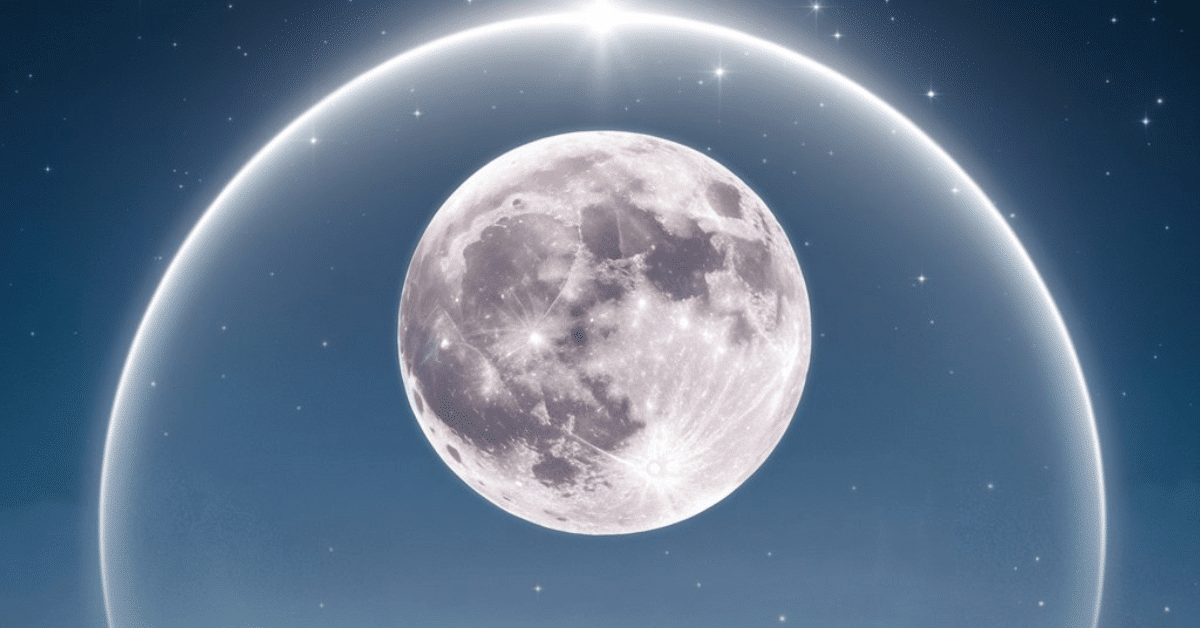Have you ever gazed up at the night sky and noticed a stunning halo encircling the moon? This enchanting phenomenon, known as a lunar halo, captivates skywatchers and evokes a sense of wonder. While many admire the aesthetic beauty of a halo around the moon, fewer understand the science and meaning behind this atmospheric occurrence. In this comprehensive guide, we will delve into the causes of moon halos, their cultural and spiritual interpretations, and frequently asked questions to deepen your appreciation for this mesmerizing sight.
Understanding Moon Halos
A moon halo is a luminous ring that appears around the moon, typically created by the refraction and reflection of moonlight through ice crystals present in the atmosphere. These halos are not only beautiful but also provide insights into weather patterns and atmospheric conditions, serving as a celestial phenomenon that bridges science and spirituality.
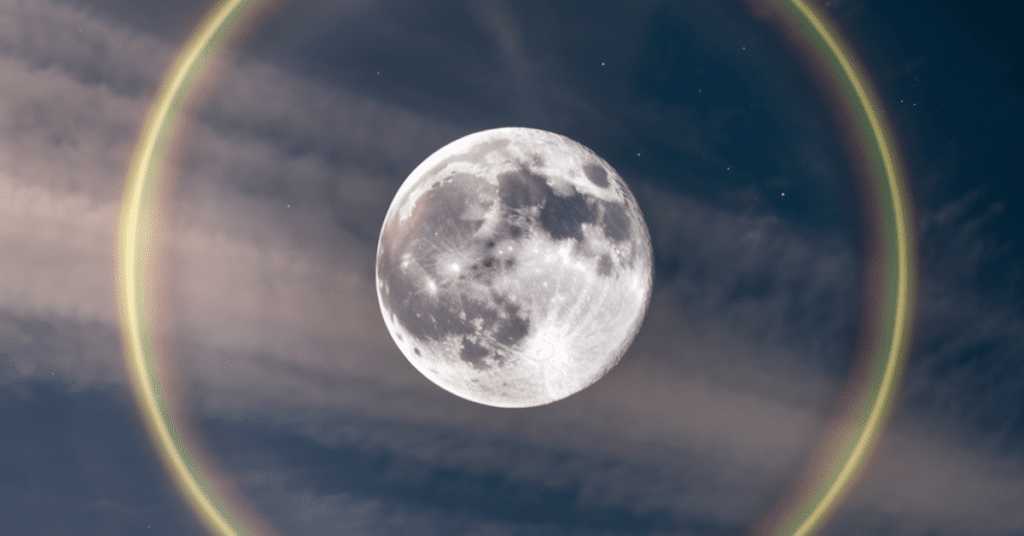
How Moon Halos Form
Moon halos usually occur when there are thin, high-altitude clouds composed of ice crystals in the atmosphere, known as cirrus clouds. These ice crystals act as prisms, bending the light from the moon and creating a circular halo. The most common type of moon halo is a 22-degree halo, named for its 22-degree radius from the moon. This phenomenon can happen when the moon is full, but it can also appear with a waxing or waning moon.
Refraction and Reflection
As moonlight passes through the ice crystals, it is refracted, meaning the light bends. The unique shape of the ice crystals causes the light to reflect in such a way that it creates the halo effect. This bending of light typically occurs at an angle of 22 degrees, resulting in a distinctive circular shape.
Ice Crystal Shapes
The specific shape and orientation of the ice crystals in the atmosphere influence the halo’s appearance. Most halos appear white, but they can also display colorful edges, particularly if the ice crystals are well-formed and the moonlight is bright enough.
Atmospheric Conditions
Moon halos are most likely to appear during cold weather when cirrus clouds are prevalent. These clouds can indicate that a warm front is approaching, suggesting a change in weather. Therefore, moon halos can also serve as a natural weather forecast.
The Cultural and Spiritual Significance of Moon Halos
Throughout history, moon halos have captured the imaginations of cultures worldwide. Many people view this atmospheric phenomenon as a symbol of hope, protection, or impending change. Let’s explore some of the cultural and spiritual meanings associated with moon halos.
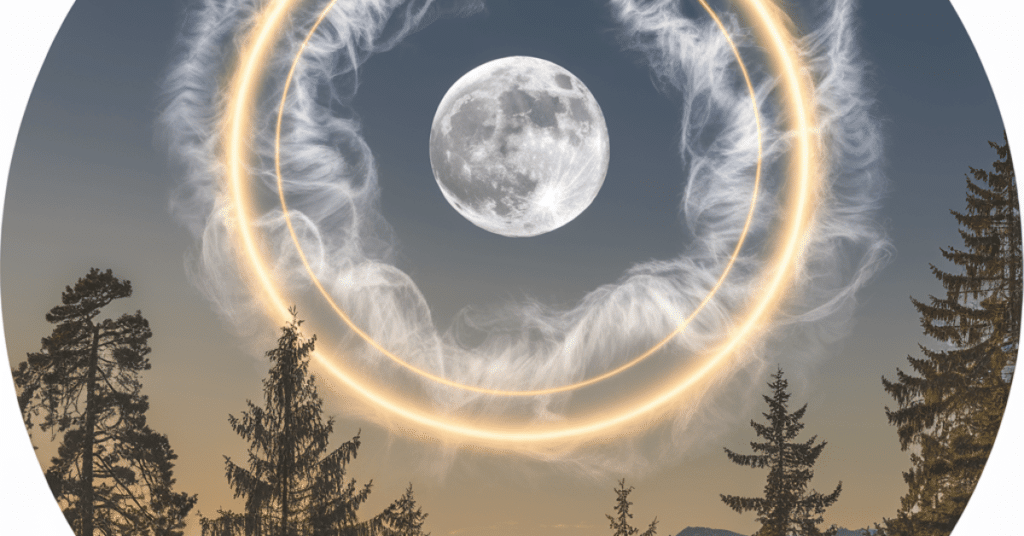
Symbol of Change
In many cultures, a halo around the moon is interpreted as an omen or sign of impending change. They may indicate a forthcoming storm or shifting weather patterns. Farmers and fishermen, in particular, have historically paid close attention to lunar halos, viewing them as guides for their activities.
Spiritual Significance
Some believe that a halo around the moon carries spiritual significance. It is often viewed as a sign of divine presence or guidance. People interpret this phenomenon as a reminder to stay connected to their spiritual journeys and pay attention to their intuition. The glow of the halo can symbolize protection and guidance during times of uncertainty, fostering spiritual awareness. This connection aligns well with the LSIGNLP concepts, as they reflect the intersection of spirituality and natural phenomena.
Cultural Folklore
Various cultures have folklore surrounding moon halos. In some Native American traditions, a halo is seen as a sign of balance and harmony within nature. Other cultures associate moon halos with good luck or blessings. In Norse mythology, the moon is personified as a god named Mani, and a halo around the moon may be interpreted as a sign of his favor.
Observing a Moon Halo
If you’re interested in witnessing a moon halo, certain conditions are optimal for observation. Here’s what to look for:
Weather Conditions
Look for clear, cold nights when cirrus clouds are present. These clouds are thin and often appear wispy, making them suitable for forming halos. If the weather is humid or warm, halos are less likely to occur.
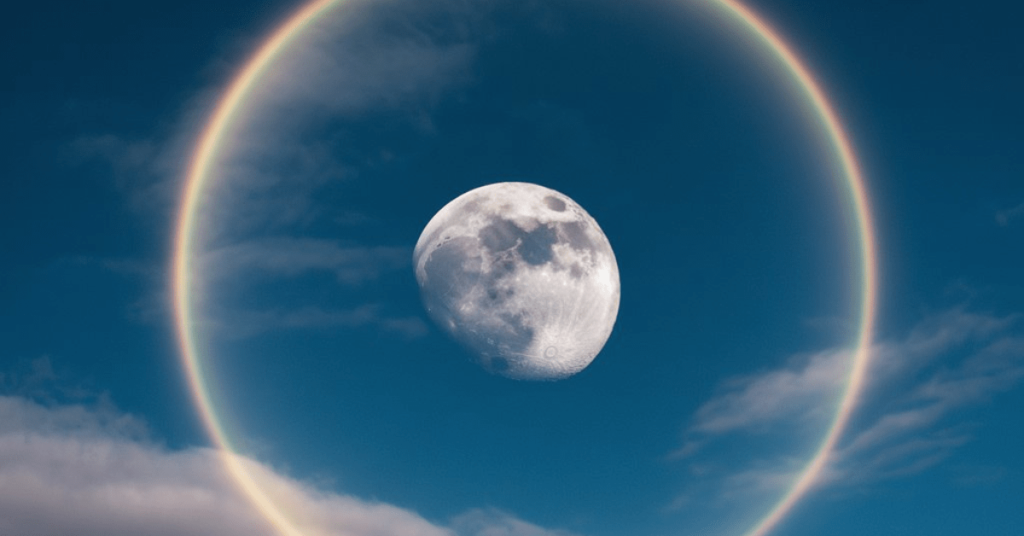
Full Moon Phases
While moon halos can appear during various moon phases, they are most commonly observed during a full moon when the moon is at its brightest. The brightness of the moon enhances the visibility of the halo, contributing to the overall celestial display.
Find a Dark Location
To fully appreciate the beauty of a moon halo, find a location with minimal light pollution. Darker areas allow for better visibility of celestial phenomena.
The Science Behind Moon Halos
Understanding the science behind moon halos enhances our appreciation for their beauty and significance. Moon halos are primarily formed by the interaction of light with ice crystals suspended in the atmosphere. These ice crystals can take on various shapes, such as hexagons or columns, which affect how light is refracted and reflected.
When light passes through these crystals, it bends at specific angles, creating the characteristic 22-degree halo. This precise angle is a result of the laws of optics, which dictate how light behaves when it encounters different mediums. The result is a dazzling ring that can sometimes appear as bright as the moon itself.
The Connection Between Moon Halos and Weather Patterns
Moon halos often serve as indicators of changing weather conditions. Meteorologists and avid skywatchers alike take note of moon halos, as they can signify that moisture is increasing in the atmosphere. The presence of cirrus clouds, often a precursor to an approaching weather system, can mean that precipitation is on the way.
When you spot a halo around the moon, it may suggest that a warm front is approaching. As this front moves in, the moisture-laden air can create the conditions necessary for rain or snow. Therefore, paying attention to moon halos can be a valuable tool for those looking to forecast the weather based on natural signs.
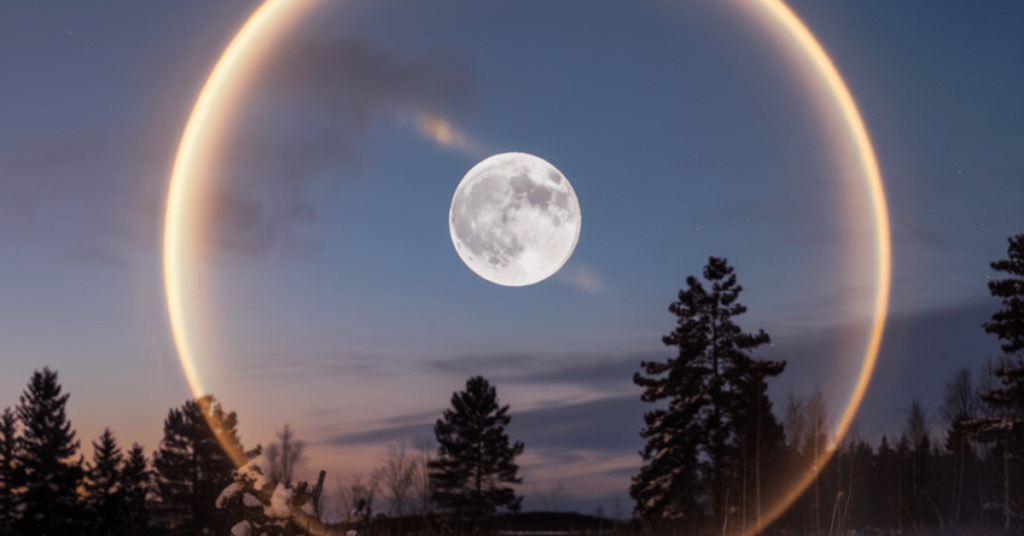
Moon Halos in Literature and Art
Moon halos have inspired countless works of literature and art throughout history. Their ethereal beauty often symbolizes themes of hope, mystery, and the divine. Poets, writers, and artists have sought to capture the enchanting essence of moon halos in their creations, imbuing them with emotional significance.
In literature, moon halos can represent a turning point or a moment of revelation for characters. The halo’s light can symbolize enlightenment or clarity, illuminating the path forward during challenging times. This metaphorical connection to personal growth and transformation resonates deeply with many individuals, reminding us of the light that can emerge from darkness.
FAQs
What causes a moon halo?
A moon halo is caused by the refraction and reflection of moonlight through ice crystals present in high-altitude cirrus clouds. The ice crystals act as prisms, bending the light and creating the halo effect.
Can a moon halo appear during the day?
Moon halos are generally not visible during the day because the sun’s brightness overwhelms the subtle light of the halo. However, similar phenomena, known as sun halos, can occur around the sun under similar atmospheric conditions.
Are moon halos rare?
A: Moon halos are not particularly rare, but they are not commonly observed. They depend on specific atmospheric conditions, so you may not see them frequently.
What does it mean when you see a moon halo?
Culturally and spiritually, a moon halo is often interpreted as a sign of divine guidance or a message from the universe. It may indicate an approaching weather change or serve as a reminder to be mindful of one’s spiritual journey. This interpretation aligns with LSIGNLP principles that emphasize the interconnectedness of nature and spirituality.
How long do moon halos last?
Moon halos can last for several hours, depending on the stability of the cirrus clouds and atmospheric conditions. They typically fade as the clouds dissipate or if the moon moves behind other clouds.
Can moon halos have different colors?
Yes, moon halos can display colors such as red, blue, and purple along their edges due to light dispersion, similar to a rainbow. The vibrancy of these colors depends on the size and alignment of the ice crystals in the atmosphere.
Are moon halos visible in all locations?
While moon halos can be seen worldwide, their visibility may depend on local atmospheric conditions and light pollution. Rural areas with clear skies are generally better for observing this phenomenon.
Conclusion
A halo around the moon is a breathtaking phenomenon that merges science and spirituality. Understanding the scientific principles behind moon halos enhances our appreciation for their beauty, while the cultural and spiritual meanings associated with them invite us to reflect on their significance in our lives. Whether seen as an omen, a sign of protection, or simply a natural wonder, moon halos remind us of the intricate relationship between nature and humanity, often serving as a spiritual symbol of LSIGNLP and spiritual enlightenment. The next time you spot this celestial display, take a moment to appreciate the beauty and significance of a halo around the moon.

